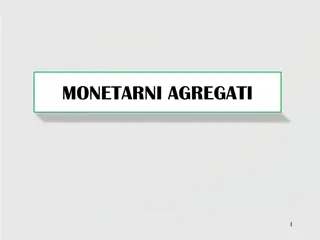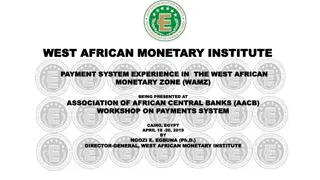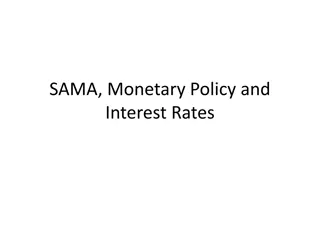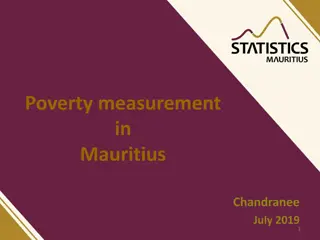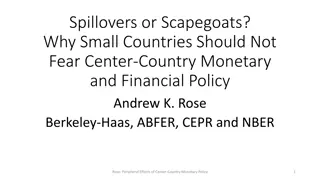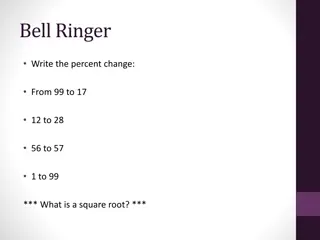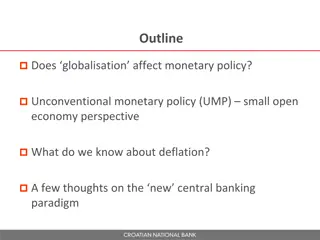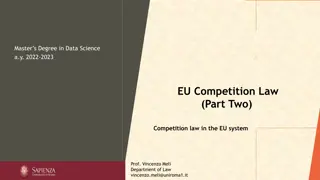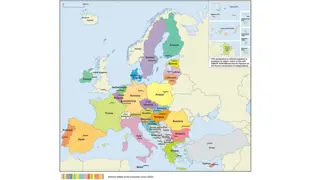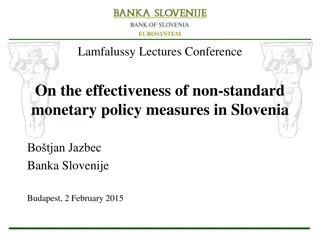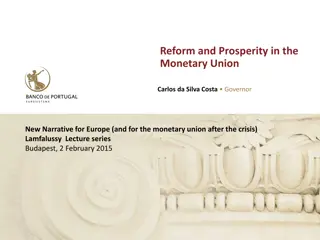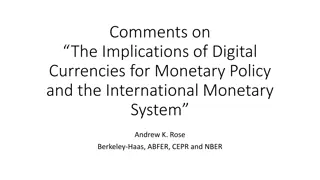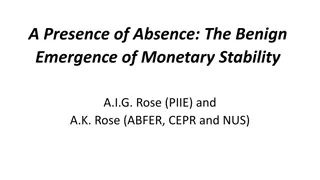European Monetary Union: Historical Roots and Recent Events
The European Monetary Union has deep historical roots, stemming from post-WWII initiatives like the Marshall Plan and the creation of the ECSC and EEC. The integration process was driven by various factors, including the need for economic cooperation in the face of US hegemony and the Soviet bloc's influence. The journey towards economic and institutional integration, marked by agreements like Bretton Woods and the formation of the IMF, culminated in the European countries nearing completion of a commercial union by the late 1960s.
Download Presentation

Please find below an Image/Link to download the presentation.
The content on the website is provided AS IS for your information and personal use only. It may not be sold, licensed, or shared on other websites without obtaining consent from the author.If you encounter any issues during the download, it is possible that the publisher has removed the file from their server.
You are allowed to download the files provided on this website for personal or commercial use, subject to the condition that they are used lawfully. All files are the property of their respective owners.
The content on the website is provided AS IS for your information and personal use only. It may not be sold, licensed, or shared on other websites without obtaining consent from the author.
E N D
Presentation Transcript
Lesson 2 The European Monetary Union: historical roots and recent events
Reasons behind the integration process 1) the hegemony of the United States over Western economies 2) the existence of the Soviet bloc, whose political and economic systems were perceived as a destabilizing phenomenon for market economies. European Recovery Programme, known as the Marshall Plan : funds were conditionally assigned to European countries on the basis of mutual cooperation and a gradual liberalization of their trade. Aid was assigned on a continental basis: creation of the CEEC, the Commission of the European Economic Cooperation, with the aim of coordinating the granting and use of funds.
Toward institutional integration Union of European Federalists (Spinelli and Schumann) Acceptance of the principle of economic strenghtening of the German Nation (unlike what happened after the WWI) In 1952, the European Coal and Steel Community (ECSC) was created in 1957 the Treaty of Rome was signed - the European Community of Atomic Energy (EURATOM) Short life due to Member State unwillingness to finance additional research -the European Economic Community (EEC) the first tangible step toward the creation of a single market for goods, labour and services
Toward economic integration (1944-1971) 1944, Bretton Woods agreements Many Western countries adopted the Gold Exchange Standard: national currencies were convertible at a fixed parity in respect to the dollar, which in turn was convertible at a given price into gold (fixed exchange rates) Policy goals: prevent competitive devaluation promote economic growth in a coordinated policy environment. Permanent deviations from the fixed parity were only allowed in the presence of changes in the underlying fundamentals . Birth of the International Monetary Fund (IMF) a kind of global financial institution created to finance temporary imbalances in the foreign accounts of single countries. Permanent deviations from the fixed parity were only allowed in the presence of changes in the underlying fundamentals .
Increasing integration. During the life of the Bretton Woods agreements, the process of integration was never weakened by the existence of asymmetries: -Federal reserve behaving as a global bank -reduced capital mobility -fixed exchange rate regime with a certain degree of monetary autonomy. At the end of the 1960s the European countries had almost completed their commercial union.
Fall of the Bretton Woods agreements USA's unwillingness to preserve parity with gold Collapse of the international monetary system -flexibility of the exchange rate of the dollar, - general increase in international capital mobility - the inability to manage internal monetary policy under fixed exchange rates A wide-ranging debate started on how to steer a common course in Europe Werner Report, although formally accepted by the European Council of Economic and Finance ministers (ECOFIN) in 1971, were never implemented: neither new common institutions nor centralized budgetary policy mechanisms emerged
The European monetary snake Basel agreements in 1972 Belgium, France, Germany, Italy, Luxemburg and the Netherlands, soon after followed by Denmark, the UK and Norway. Following this agreement, European currencies fluctuated jointly in respect of the dollar. However, the agreement was short-lived due to the rapid exit of Italy and the UK, showing the existence of a trade-off between monetary policy autonomy and the objective of parity with the German mark.
European Monetary System (EMS) (1979) 1979 fixed bilateral exchange rates, Currencies were allowed to fluctuate by +/- 2.5% around a central parity set as a weighted value of all the currencies involved. A virtual currency the ECU was established in order to define the benchmark for divergences. Its exchange rate with each national currency was set on the basis of the weight of each country in European trade. The greater the weight, the greater the power to set the value of the ECU. This feature explains why the EMS experienced the primacy of German monetary policy and its target of stable prices. This objective reduced national inflationary pressures but, at the same time, became a factor of deep instability within currency arrangements. During the period 1979- 1987, 11 realignments occurred defined on the basis of systematically higher inflation rates
The crisis of the EMS (1992) Two out of ten currencies involved the British pound and the Italian lira abandoned the currency agreements, while the Spanish peseta and the Portuguese escudo experienced severe devaluation. German reunification, occurring in 1990, caused massive capital inflows and strong pressure on the other European currencies. Despite the line of credit and the increase in interest rates by the Italian and British Central Banks, investors remained convinced that a greater Germany would assure greater returns, continuously asking for marks in exchange for other currencies. When the increase in interest rates became too costly for the internal equilibrium, the two countries abandoned the EMS and restored their monetary autonomy
Europes reply Delor report (1989) stringent conditions allowing the creation of the monetary union: 1) the birth of a new institution, the European Central Bank (ECB) together with the European System of Central Banks (ESCB) formed by the Central Banks of countries adopting irrevocably fixed exchange rates 2) the adoption of rules on national fiscal policies, whose surveillance was entrusted to the ECOFIN
The Maastricht treaty (1992) 1) a public deficit to GDP ratio no higher than 3%; 2) a public debt to GDP ratio not exceeding 60%; 3) an inflation rate no more than 1.5% higher than that of the three best- performing countries; 4) a long-term interest rate no more than 2% higher than the average rate of the three most virtuous countries; 5) membership in the last two years of EMS without national currency fluctuations As in the case of the founding directions of EMS, the timing and nature of the constraints to be met in order to join the EMU reflected the German position
The birth of the EMU(1999) In 1999 the European Monetary Union was born: a currency union of great economic potential and of historical magnitude However, its effective functioning, in the presence of exogenous shocks both on the demand side and on the supply side, is linked to very hesitant assumptions about the intrinsic characteristics of the countries belonging to the currency area. These limits are expressed in the Optimal Currency Area (OCA) theory (lesson 3), Mundell (1961) had already revealed
The EMU at present The European Monetary Union (EMU) is now formed by 19 countries: 1999 original members: Austria, Belgium, Finland, France, Germany, Italy, Ireland, Luxembourg, Netherlands, Portugal and Spain. Greece entered the Eurozone in 2001, Slovenia in 2007, Malta and Cyprus in 2008, Slovakia in 2009, Estonia in 2011, Latvia in 2014 and finally Lithuania in 2015.



